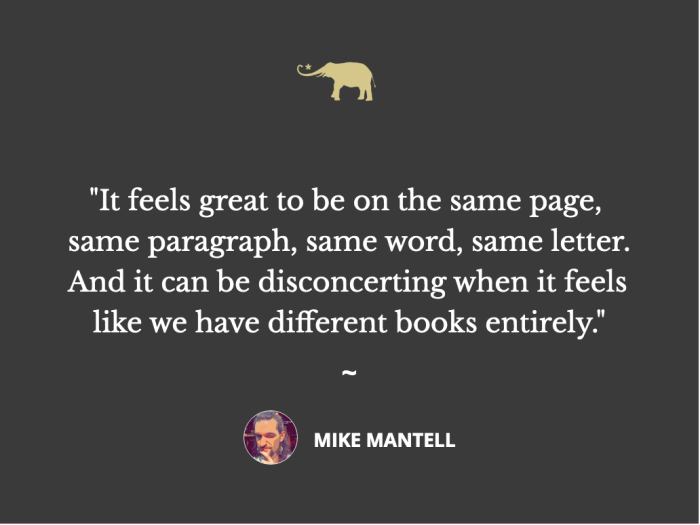There are a bunch of tools that can teach us to more gracefully navigate conflict in our relationship, or to ignite our sexual chemistry.
And while a thriving relationship does require all these building blocks, they are all secondary to having a solid foundation.
The foundation of a healthy relationship is simply this:
Be as deeply in connection as possible, as often as possible.
How do you know if you are in connection or out of connection?
While there are degrees of how connected we are with our partner at any given time, there is also a threshold of when we are disconnected from each other.
If we feel love, good will, playful, and/or warm appreciation toward our partner, then we are in connection.
If we feel like we’re on different teams, against each other, cold, or distant, then we are out of connection. If we wander past each other like strangers living in the same house, this is the culmination of disconnection.
That’s not to say we shouldn’t take alone time—we should. And if we and our partner live together and both work from home, we’ll have to disconnect for parts of the day. While Angela and I were living in a studio together, it was crucial to have hours of the day where we were in “noble silence,” where we intentionally pretended the other was invisible in order to simulate solitude in a cramped space.
But when we are not in a container of shared solitude, then the goal is to optimize depth and frequency of being in connection.
Disconnection Corrodes the Relationship
Think about being at dinner with your partner. How dismal is it to both be on your phones and disengaged from each other? Or how equally dismal is it to feel like there’s some unnamed, wooly mammoth in the restaurant, something in the air where it feels tense, awkward, and unnatural? How unpleasant is it for your partner to be sitting constantly on your nerves, where you can’t look past your annoyance and remember what you love about them?
It feels great to be on the same page, same paragraph, same word, same letter. And it can be disconcerting when it feels like we have different books entirely.
Relationship researcher, John Gottman, studied thousands of couples over years, and he found (with 92 percent accuracy) that the following communication patterns predict divorce: contempt, criticism, defensiveness, and stonewalling.
While each of these could be further analyzed, they all share a commonality: each of these communications reflect the internal experience of disconnection.
The 3 Types of Disconnection, and How to Get Back in Connection
There are three main ways that a couple may find themselves in disconnection, and simple solutions to find connection again.
1. A trigger comes up that you don’t address in the moment.
Let’s say you were doing the laundry, and your partner subtly digs at you for folding the laundry wrong. They had an outburst of anger and then experience guilt. You experience shame, inadequacy, and defensiveness. But if you don’t talk about these emotions in the moment, they will burrow inside of each of you and live as smog in your connection.
If we never voice these subtle trigger moments, they’ll rot into resentments. The other person will slowly morph into an ugly ogre who does nothing right and whose very sight repels us.
How to get back into connection:
Once a week, put a timer on for 15 minutes. In those 15 minutes, sit across from your partner in eye contact. Feel the connection with each other and both respond to the prompt, “What do I need to say to clear the connection?”
Talk through all the little emotions that went unnamed. Fess up to your part in the matter and take responsibility for your own feelings.
2. There is a greater undercurrent in the connection that needs to be named.
It’s possible that things feel wonky because your relationship is going through a transformation that hasn’t reached your conscious awareness yet. Your relationship is its own being; you and your partner are showing up to encourage that being’s full and true expression.
Big undercurrents tend to signify that the relationship has changed or shifted, and you and your partner haven’t realized yet. So you are both still holding onto the old shape of the relationship.
Being disconnected in this way is like using a laggy computer. With your hand on the mouse, you jolt your arm to the right. But it takes a few seconds for the arrow on the screen to catch up to its actual location—just as your perceived connection with your partner may take time to catch up to the actual state of the relationship.
This happens naturally as you both grow as individuals and as the relationship itself grows. It can also happen if one of you travels and you both experience transformation independently, then you must come back together and get to know the new person and fall in love again.
Some undercurrents signify no concrete change in the relationship—just a matter of recalibrating. Though other undercurrents may indicate that your relationship is reaching a new stage that must be acknowledged.
Maybe you want to merge finances, start a business together, or buy a house.
Maybe you want to sleep in separate bedrooms, change your relationship paradigm, or go on a long solo vacation.
None of these undercurrents are better or worse. Each relationship is its own entity, and your job as a partner is to let it evolve how it wants to (noting, of course, that the relationship is made up of your and your partner’s desires).
Until the undercurrent has been named in your connection, you’ll both feel like you’re showing up for each other, but you’re not quite “clicked” into place.
Relationship is like this: you and your partner are in a dark room together. If you communicate and share intimacy, you fuel the relationship itself. By listening to the relationship and what it wants, you will find yourself standing next to each other—their index finger resting gently on your index finger.
When you’re really dialed in connection, it might feel like you are two needle points touching each other. But if you have an unnamed undercurrent, it’s like you are in the dark room, moving your hand about, looking for your partner and their finger to touch, but you can’t quite find each other yet. You trust they are nearby but are grasping in dark air for each other.
How to get back into connection:
First, trust the waves of change. The unknown can be scary, but remember that being disconnected in this way isn’t bad. It’s natural, and it means that you are both growing, and you are letting your relationship grow. That is worth celebrating.
Then have a candid conversation and answer the prompts:
>> How connected do I feel to you?
>> Do either of us have any desires that we haven’t named yet?
>> How does our relationship want to evolve, and what does it want us to let go of?
>> Be patient, and trust that if we keep showing up for each other, the truth of our connection will reveal itself.
3. The relationship is out of balance.
Every couple has their modes of connecting that make their relationship whole.
For example, while my partner Angela and I connect in many ways, here are our three main modes:
- Going on long walks and processing life together. This allows us to share vulnerably, connect philosophically, and feel in tune with each others’ life journeys.
- Dance, tantra, kink, sex. This brings our bodies into presence and lets us work through any underlying emotions together.
- Acting like kids. This helps us have fun together and bring joy out of each other.
At any given time, if one of our modes is being underfed, then we will feel in a disconnect. We’ll know we still love each other, but it will feel like something is missing and like the relationship doesn’t feel whole.
If we’ve been processing a lot, we may feel too heady, and we need our bodies to get primal with each other.
If we’ve been spending too much time in deep, emotional, embodied spaces, things may feel too sacred and serious. Time to let the trickster out and act like childish fools together.
If we’ve been constantly joking and playing, we may be avoiding deeper conversations we need to have and need to go into a sincere verbal space.
How to get back into connection:
Sit with your partner and find answers together on the following:
>> What are our main modes of connection as a couple?
>> Do any of our modes feel underfed?
If you’re not sure about your main modes of connection, you could also more generally reflect together on:
>> How is our “mind” connection? (intellect, ideas, conversation)
>> How is our “body” connection? (cuddling, sex, dance)
>> How is our “spirit” connection? (being in nature together, feeling cosmically aligned, feeling your life paths move in the same direction)
>> How is our “heart” connection? (affection, doing nice things for each other, seeing the good in each other)
>> How is our “child” connection? (games, play, jokes, feeling cute)
Being in connection is the name of the game.
Hopefully, some of these tips help you and your lovey-poo learn more about how you disconnect and how you can get back into connection.
~










Read 10 comments and reply